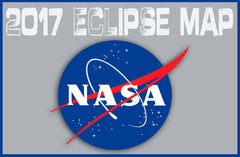2017 Solar Eclipse
On August 21, 2017, millions of people across the US saw one of nature's most amazing spectacles - a total eclipse of the Sun. It was a beautiful sight to see; the Moon completely blocking the Sun, daytime becoming a deep twilight, and the Sun’s corona glowing in the darkened sky. Oh, and the people came. Boy oh boy did the people come! Check out the information below to show how we prepped everyone on how to best view this historic event.

August 21st, 2017: Total American Eclipse
A total solar eclipse will take place on Monday, August 21, 2017. A solar eclipse occurs when the Moon passes between Earth and the Sun, thereby totally or partly obscuring the image of the Sun for a viewer on Earth. A total solar eclipse occurs when the Moon's apparent diameter is larger than the Sun, blocking all direct sunlight, turning day into darkness. Totality occurs in a narrow path across the surface of the Earth, while a partial solar eclipse will be visible over a region thousands of miles wide.
The eclipse will have a magnitude of 1.0306 and will be visible from a narrow corridor through the United States (see the map above). The longest duration of totality will be 2 minutes 44.3 seconds just south of Carbondale, Illinois.
Why does any of this matter? Let's get you excited about how amazing this moment will be:
- This will be the first American eclipse to occur since February 26, 1979. Unfortunately, not many people saw it because it only touched five states in the Northwest and the weather for the most part was not great. Before that one, you have to go back to March 7, 1970.
- Everyone in the continental U.S. will see at least a partial eclipse. In fact, if you have clear skies on eclipse day, the Moon will cover close to 50 percent of the Sun’s surface.
- Astronomy specialists are claiming that this eclipse will be the most-viewed ever! This is based on four factors: 1) the attention it will get from the media; 2) the superb coverage of the highway system in the US; 3) the typical weather on that date; and 4) the vast number of people who will have access to it from nearby large cities.
- It's estimated that close to 100 MILLION people in the United States will see the sun covered by at least 90%. That is absolutely mind blowing!
- Totality will be safe to look at. During the time the Moon’s disk covers that of the Sun, it’s safe to look at the eclipse. In fact, to experience the awesomeness of the event, you must look at the Sun without a filter during totality. You MUST! For the rest of the eclipse, glasses please!
- All you will need is Eclipse Glasses- no telescope needed! One of the great things about the total phase of a solar eclipse is that it looks best to naked eyes. The sight of the corona surrounding the Moon’s black disk in a darkened sky is something you will not forget.
- Nature can be so cool! Depending on your surroundings, (as totality nears) you will experience strange things. Look around. You’ll notice a resemblance to the onset of night, though not exactly. Areas much lighter than the sky near the Sun lie all around the horizon. Shadows look different. Listen. Usually, any breeze will dissipate and birds (many of whom will come in to roost) will stop chirping. It is quiet. Feel. A 10°–15° F drop in temperature is not unusual. Can't wait!
Now the real question, where will you be on August 21, 2017?



